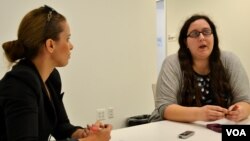The vast majority of autistic children in the U.S. are educated in regular classrooms: Ninety percent of autistic children in the United States spend time in the same public school classes attended by non-autistic children, according to the U.S. Department of Education. But some activists say more could be done to integrate autistic children into mainstream education.
The U.S. Center to Disease Control and Prevention estimates that one in 68 American children are somewhere on the autism spectrum, a range of developmental disorders that can affect behavior and impair communication and social interaction.
Julia Bascom is Deputy Executive Director of the Autistic Self-Advocacy Network, a nonprofit organization advocating disability rights and seeking to increase the representation of autistic people in society. She was diagnosed with autism when she was 16, while taking academically challenging classes in a New Hampshire public school.
“I was in a lot of advanced classes and also doing a lot of independent study because I had a hard time being in the classroom,” Bascom said. “When I was diagnosed with Autism Spectrum Disorder (ASD) my parents asked for an Individualized Education Program (IEP).”
Such customized education plans are mandated by federal law. Under the federal Individuals with Disabilities Education Act, or IDEA, children with special needs, such as autism, have the right to share the same public school classroom as all other students. The law also requires local public schools to support children with disabilities so they can learn the same content as other students.
But Bascom says the way her school interpreted the rules would have limited her education.
“The school district said that if I got an IEP I wouldn’t be able to stay in any of the advanced classes,” she said. “So I didn’t get any support or services through school”.
Sometimes efforts to provide autistic children with the support they need can conflict with the goal of integrating them into normal classrooms. Many autistic children, as part of their IEPs, are tutored by teaching aides who help them work on tasks or specific subjects they are struggling with. This can include speech therapy and other ways to improve communication skills. All the special help can result in the children spending most of their school time outside the regular classroom in what are called “self-contained classrooms.”
“Children who are part of those self-contained classrooms don’t have the chance to go out of those designated classes,” said Bascom. “Students in these environments don’t learn the same material and they don’t do as well as the students with same disabilities that are integrated into regular classrooms.” They can be “trapped in a narrow set of options,” she says.
Those options may be even narrower when it comes to college. The special education support requirements of the IDEA act only apply up through high school. Students with significant intellectual disabilities, including some students on the autism spectrum, have not traditionally gone to college especially if they need special assistance.
“In the last several years there has been an expansion of programs designed to get students with intellectual disabilities a college experience,” Bascom says.
Whether in elementary school, high school, or college, Bascom believes integration in mainstream classrooms has life-long benefits.
“Students who participate in these programs are more likely to get a job and live independently, and so get a result of whole education.”







